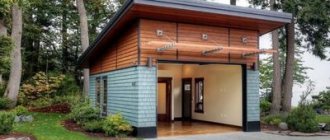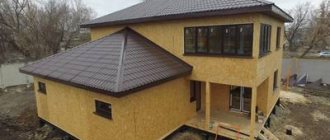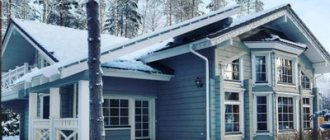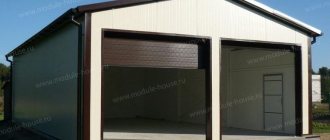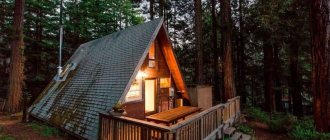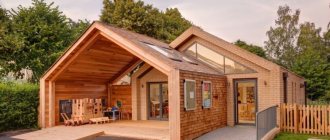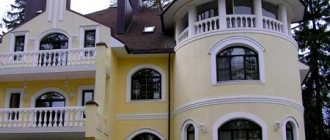There are various illustrative examples of floating buildings in India, Holland, Canada, Germany, and other countries that could not remain unnoticed by their compatriots.
Floating houses have now become very popular even in the Russian Federation. There are a lot of water areas in the country suitable for this type of construction.
Houses that are located on the water have many advantages that will determine the growth of interest in these types of buildings.
Types of floating residential buildings, their features
Shops and restaurants, night clubs, and entertainment centers are being created on the water. It is possible to build a residential building of this type. A floating house can be:
- seasonal or year-round;
- landline or mobile;
- located in the settlement and outside its borders;
- equipped on a ship foundation, piles, pontoons.
Houseboat on a pontoon
For the most part, these structures are used as summer cottages and are intended for use during the warm season. But modern construction technologies and materials make it possible to equip a comfortable home for permanent residence.
Stationary structures do not move across the water area. They can be connected to land by rafts, bridges, and gangways. Sometimes such buildings are erected far from the shore; they can only be reached by small vessels. The mobile home is equipped on a keel-shaped, flat-bottomed base and can move along a lake or river under its own power or be towed if necessary to change the installation location.
Stationary houseboat
Houseboat pontoons are the most popular base. These structures provide the building with a stable position, reliability, and long service life. Pile foundation can be used for housing on water
Slab or pile foundation - how to choose
So, we have determined that when the groundwater level is high and water is close to the site, among all the foundation options there are two left - pile or slab.
A floating concrete structure is suitable for soils with weak bearing capacity and water-saturated soils.
This is, in fact, a monolithic slab of concrete reinforced with steel rods, quite thin. It is installed in a dug pit on a sand or crushed stone bed; concrete is poured into the reinforcement frame around the perimeter.
The advantages of a concrete slab are that such a floating foundation perfectly withstands heaving and soil movement, moving with these forces along with the building and evenly distributing the load. As a result, the structure will not sag or suffer.
But a slab foundation also has many disadvantages:
- You can install a concrete slab only if the slope of the site is no more than five degrees. If the site is being prepared for building a house, it must be perfectly leveled. Placing the slab even at a slight slope is dangerous because over time, due to soil vibrations, the house can shift and even collapse.
- Arranging a slab floating foundation will require a lot of time, effort and money. The scope of work is very large: leveling the site, preparing, filling and leveling the base for the foundation, its thermal insulation and protection, installation of concrete and waterproofing, etc.
The most popular solution for country house construction is a foundation on reinforced concrete piles.
A classic pile foundation can only be used if the peat layers in the area are shallow. If groundwater comes close to the surface, only a pile-screw foundation is suitable. That is, piles are used with a bladed screw at the end, which is screwed manually or using machinery into hard layers of soil.
Such a foundation is several times cheaper than a slab, does not require lengthy preparation for installation, and is ideal for flooded and swampy areas.
There are only two restrictions:
- not suitable for the construction of heavy multi-storey buildings, for example, made of brick
- not suitable if hard soil is too deep.
After assessing the characteristics of the building site, a foundation on screw piles often turns out to be the only option that ensures the reliability of the building even on the most difficult soils, including swampy, peat and flooded soils. And at the same time its cost is affordable.
Legal features of floating housing
The legislation provides for certain restrictions for such buildings. Their length should not exceed 20 m, the weight of the building can be up to 80 tons. There is a limit on the number of people living in the house. There should not be more than 12.
The dimensions, weight, and location of the structure on the water place it in the category of a small vessel. This legal status provides owners with several significant advantages. They do not need:
- deal with registration and purchase of land plots;
- obtain permission from the administration to build a house;
- register real estate with the relevant authorities;
- pay residential property taxes.
For a house on the water you do not need to obtain a building permit
This housing also has its downsides. Registration in them is not issued. It is impossible to obtain a mortgage loan for such construction.
The building must be registered. Since this is a small vessel, the procedure is carried out by the appropriate state inspection. She issues the owner a ship's ticket. It gives the right to move around the water area without interfering with navigation. The owner of the house has the right to decorate it with the Russian flag.
Total
For the construction of houses and other buildings on waterlogged, swampy soils or in areas with a large slope and annual spring floods, the ideal solution would be a foundation on screw piles. It will allow, with a minimum expenditure of money, time and effort, to build a reliable foundation for a future home or household building.
The pile screw is screwed into the soil, and its structure remains intact, while compaction of the soil occurs. The blades of the pile evenly distribute the load along the base of the foundation. As a result, neither the high groundwater level nor the forces of frost heaving of unstable marshy soils threaten the structure.
It is important to entrust the installation of a pile-screw foundation to professionals and take care of the correct choice of the type and depth of piles. Pile supports must be treated with an anti-corrosion compound and filled with concrete after installation. Only under these conditions and following the correct installation technology will a pile-screw foundation on water-saturated soils last for many years.
Advantages of a house on the water
It is enough to look at photos of houses on the water to appreciate the advantages of such a location. In the warm season, the following are organized directly on the territory of the building:
- fishing,
- sunbathing,
- bathing,
- a relaxing holiday amidst beautiful scenery.
A house on the water will give you relaxation among beautiful landscapes
Residents of the house are not left without entertainment and useful rest in the winter. The house is located on the territory of a natural skating rink, you can go ice fishing and go skiing. Permanent housing is often equipped with saunas and steam baths, and after a steam bath it is possible to plunge into an ice hole. At any time of the year, the house is an excellent place for an outdoor picnic.
In winter, after the steam room there is an opportunity to plunge into the ice hole
A mobile structure makes it possible, if desired, to move with the house without experiencing problems with transporting the house and things.
Features of installing a pile foundation on water-saturated soils
Piles have long been used as the foundation of buildings on unstable soils. This solution allows you to transfer the load from the upper, unstable due to groundwater, layers of soil to the lower, dense and stationary layers.
The foundation on screw piles is installed in soil with any terrain, including marshy soils and peat. In these cases, the pile passes through a loose layer of soil and is fixed in a dense layer - soil movements of such a structure will not cause damage.
A pile foundation does not require preliminary excavation work; the piles are screwed manually directly into wet ground and even into a shallow reservoir.
It is important to buy factory-made screw piles so that the material, design and anti-corrosion treatment are not in doubt. Only with this approach will the foundation last for decades.
After installing the piles, their cavity is filled with concrete mortar. This will not only strengthen the structure, but also protect the metal from corrosion, which is especially important in water-saturated soils.
Having calculated the level of soil freezing, screw piles are screwed in below this point, which avoids the influence of soil heaving forces on the house.
Work on installing a pile-screw foundation can be carried out all year round. Immediately after installing the foundation, you can build a house or building: there is no need to wait for the foundation to shrink in the case of a pile foundation. Simultaneously with the installation of such a foundation, communications can also be laid.
The technology for installing piles is quite simple, but it is better to entrust it to professionals. This is the only way to correctly select the type, length and diameter of the piles based on the characteristics of the soil and the weight of the future house, install the piles at the desired angle (deviations are unacceptable), level (cut or build up) to a single level, and then connect the structure with a grillage. Only compliance with all these conditions and qualified installation of a pile-screw foundation will allow the load to be evenly distributed on the foundation.
Specifics of building a floating house
Many people who want to have a summer cottage on the water purchase ready-made factory buildings. This simplifies the construction process. But you need to take into account that the size of such structures is minimal. Their width is limited by transportation capabilities. If you need to build a spacious building for permanent residence, you need to build it on special pontoons for floating houses. This makes it possible to increase the area.
The construction of a pontoon will make it possible to increase the area
Pontoon bases can be made from:
- steel elements;
- reinforced concrete materials;
- fiberglass.
The choice depends on the dimensions of the house, the specifics of construction, and operation. Reinforced concrete structures are highly resistant to loads, durable, and are excellent for the construction of permanent structures. Decent technical indicators of steel structures. Provided they are well assembled and have reliable anti-corrosion treatment, they perform their functions for many years.
The choice of pontoon depends on the size of the house
Fiberglass pontoons for floating houses appeared relatively recently. But their popularity is growing rapidly. The material has high strength, does not corrode, and is durable. In addition, such pontoons weigh much less than their steel and reinforced concrete counterparts.
A mandatory element of the structure should be a durable metal frame. It will not allow the geometry of the house to change. All elements are treated with moisture-repellent and anti-corrosion agents. The design of a house should be entrusted to qualified specialists. They will correctly calculate the center of gravity and take into account wind loads.
Materials with minimal weight are used in the construction of the building
In creating the building, materials are used that have increased resistance to loads and minimal weight. The premises in the house should be compact. In finishing, preference is given to panel materials that can maintain integrity when rocking. It is undesirable to use plaster or putty, which crumbles when moving around the house.
There is an economical construction option that significantly speeds up the construction process. You can build a house on the water from used sea containers. Containers of 20, 40 feet are manufactured taking into account difficult operating conditions. It can withstand high humidity, vibration, pitching without loss, and is durable.
Economical floating houses from containers
Details
Legal nuances of a floating house
The legislation provides for some restrictions for such types of buildings. Their length should be no more than 20 meters, and all buildings can weigh up to 80 tons. If there is a limit for the number of people who live inside the house. There should not be more than 12. The weight, dimensions, and location of the building on the water can be classified as a small-sized vessel. This legal statute can provide several tangible benefits to home owners.
They won't need:
Engage in registration and acquisition of land plots.- Obtain permission to build a house from the administration.
- Register real estate with certain authorities.
- Pay residential property taxes.
Yes, yes, for a house located on the water, you really do not need to obtain a construction permit. But there are still certain disadvantages. It is impossible to obtain a residence permit in such a house, and it is also impossible to obtain a mortgage loan for construction. The construction will need to be registered, and since we are talking about a small vessel, the procedure will be carried out by a special state inspection. It will issue the owner a ship ticket, which gives the right to move around the water area without interfering with shipping transport. The owner of the house also has the right to decorate it with the Russian flag.
Advantages of houses located on the water
It’s enough to just look at photos of houses on the surface of the water to truly appreciate the advantages of such a location. In the warm season, the following will be organized directly on the construction site:
- A relaxing break in incredibly beautiful scenery.
- Bathing.
- Sunbathing.
- Fishing.
Houses on the water will give you relaxation among incredibly beautiful landscapes. Residents will not be left without entertainment and useful rest during the winter season. The house will be located on the territory of a natural skating rink, and you can go ice fishing and skiing. Housing for year-round use is often equipped with a bathhouse, a sauna, and there is also the opportunity to plunge into an ice hole. In any season, such a house will be an ideal place for an outdoor picnic. In winter, you can even take a dip in the ice hole after the steam room. Such a mobile building will make it possible, if desired, to move with the house, without experiencing difficulties in transporting things and the house.
Specifics of building floating structures
Is it possible to build a house on the water? Of course! Most people who want to acquire a personal summer cottage on the water buy ready-made factory-made buildings. But you should take into account the fact that the dimensions of such buildings are minimal. If you need to build a spacious building for year-round living, you will need to build it on special pontoons for a floating house. This will give you a chance to increase the area. Pontoon buildings make it possible to increase the usable area of the building. Pontoon type bases can be made from:
- Fiberglass.
- Reinforced concrete materials.
- Steel elements.
The choice will depend on the size, construction specifics, and also operation. Reinforced concrete structures have high load resistance, durability, and are also perfect for building permanent buildings. Steel structures have decent technical properties. Provided they are assembled of high quality and have reliable anti-corrosion treatment, they will perform their functions for many years. The choice of pontoon will largely depend on the size of the private building. Fiberglass pontoons for floating houses appeared relatively recently, but their incredible popularity is rapidly growing. The materials are highly durable, will not be subject to corrosion and are durable. Moreover, such pontoons weigh much less than their steel or reinforced concrete counterparts.
A mandatory part of the structure must be a high-strength metal frame. It will not allow the house geometry to change. All elements are treated with moisture-repellent and anti-corrosion compounds. Designing a house requires entrusting it to qualified craftsmen. They will correctly calculate the center of gravity, and will also take into account wind loads. When building a structure, materials with minimal weight are used. When creating a structure, materials are used that have increased load-bearing strength and minimal weight. The rooms inside the house should be compact, and when finishing, preference is given to panel materials that can maintain integrity when rocking. It is also important not to use putty or plaster, which will crumble when moving around the house.
There is another option for alignment, which is more economical, which significantly speeds up the alignment process. You can build a house on the water from used shipping containers. 20 and 30 foot containers are usually made to withstand quite difficult operating conditions. It can withstand high levels of humidity, motion, vibration without loss and is durable. The photo shows economical floating houses made from containers.
Communications inside the floating structure
Regardless of the type of residential building or its location, it is required to provide ideal living conditions. If floating buildings are located on the border of a settlement, located near the shore, there is a chance to connect to the central sewer lines and water supply. Comfort inside the house can be ensured even in the absence of bank systems. The modern market offers a huge number of equipment for setting up autonomous communications. The house can accommodate:
- Septic tanks for collecting wastewater.
- Electric generators.
- Containers containing fuel.
- Reservoirs containing a supply of drinking water.
Household convenience can be ensured even if there are no city communications. Installation of such systems provides excellent living conditions. There is no need to create water reserves for domestic needs. A heating system must be installed in a house for year-round use. Fireplace stoves (cast iron or steel) help maintain a comfortable temperature. It is possible to supply a system of electric and gas convectors. It would be advisable to equip these buildings with electric or infrared “warm floors”. It is the fireplace stove that helps maintain a pleasant temperature.
Communications on a houseboat
Regardless of the type of residential building or its location, it is necessary to ensure decent living conditions in it. If the floating structure is located within the boundaries of the settlement, located near the shore, it is possible to connect to centralized sewerage and water supply lines. Comfort in the house can be ensured even in the absence of coastal systems.
There is a lot of equipment available on the modern market for arranging autonomous communications. The house may have:
- reservoirs with a supply of drinking water;
- fuel containers;
- electric generators;
- septic tanks for collecting waste water.
Household comfort can be ensured even in the absence of city communications
Installation of such systems will provide proper living conditions. There is no need to create water reserves for domestic needs.
A house for permanent residence must be equipped with heating systems. Steel or cast iron fireplace stoves will help maintain a comfortable temperature. You can install a system of gas and electric convectors. It is advisable to equip infrared or electric “warm floors” in such buildings.
The fireplace stove will help maintain a comfortable temperature
Which foundation is suitable for water-saturated soils?
To choose a reliable foundation, you need to determine how high the groundwater lies. Moreover, you cannot rely on the assessment of your neighbors’ site: your particular site may be located lower, and the soil structure is different even on the same construction site.
To determine the level of groundwater in the fall or spring, a hole is dug at the site, one meter by meter, three meters deep and covered from precipitation.
If after a couple of days the depression is filled with water a meter or more from the bottom, it is impossible to build on such an area or serious drainage is needed.
Houseboat Design Options
The rapid growth in popularity of such structures has stimulated the interest of architects and designers in the development of structures of this type. On the Internet you can find many photos of houses on the water for every taste and budget. The galleries have simple, uncomplicated buildings for seasonal living and recreation. You can also see in them full-fledged original houses that can provide comfortable permanent residence for a family.
A large floating house can provide comfortable permanent residence
The variety of options allows everyone to make a good choice. Photos of houses on the water can be used as a basis, the layout is made to your taste, and additional architectural elements are arranged. Floating buildings:
- can be performed in any style;
- include from two to six full rooms;
- There are one- and two-level;
- equipped with open terraces, roof decks, etc.
Two-story houseboat
The owner of a future house on the water has the opportunity to reflect all the requirements and wishes in the project.
What threatens a high groundwater level for a foundation?
A large amount and high level of groundwater harms the foundation for several reasons.
Firstly, groundwater is saturated with salt solutions. If the foundation is made of concrete, in such an aggressive environment it will quickly delaminate and become covered with plaque and fungus.
Secondly, when building a house on such soil, there is a great danger that over time groundwater will wash minerals out of the soil, and this will weaken the soil. As a result, the construction of even a light building, such as a bathhouse or a garage, will become a problem.
Thirdly, when building a foundation on waterlogged soil, the upper, supporting layer of soil loses stability and becomes mobile. This threatens the strength of the foundation of the future home.
For these reasons, the main condition for successful construction on water-saturated soils is to think through and organize the drainage system on the site.
Another condition is the correct choice of foundation.
Due to the fact that water-saturated and swampy soils are prone to heaving in winter, because under the peat layer there is hard soil, and when the water in the soil turns into ice, the soil is deformed. This circumstance puts an end to the classical types of foundation.
Features of design and operation of floating housing
Upon completion of the construction of the house, it must be registered with the state inspection of small boats. A copy of the issued ship ticket should be made by a notary and kept at home. Regular inspections will be required. Transport tax is paid annually.
Most houseboat owners have to receive unexpected visitors in the form of administration representatives. While such buildings are rare, not in every region the authorities are well aware of the laws that do not prohibit small vessels from mooring in any place where there is no parking ban or interference with navigation. In order to eliminate any misunderstandings and claims, you should contact the administration and conclude an agreement with it on the provision of water area for recreational purposes. Such a document is drawn up for 20 years.
The floating house is required to be registered with the state inspection of small vessels
The legislation provides for certain requirements for the safe operation of such buildings. The owner of a floating house must:
- equip it with general and personal fire-fighting primary means;
- install a signaling lighting system;
- purchase life-saving equipment - rafts, boats, lifebuoys.
The houseboat must be equipped with life-saving equipment
The structure must have qualified technical documentation that complies with current construction, sanitary and hygienic standards and regulations. Persons living in floating housing must comply with environmental protection requirements and not create a risk of pollution of the water area.
Communications and foundation
If you have designed the pontoon and the building itself, you must resolve the issue of communications.
What needs to be carried into the house:
- sewerage,
- water pipes,
- electricity,
- heating.
Sometimes it is possible to connect to city communications, but this is not always the case.
If the location of your home precludes such a connection, the best option is to purchase autonomous systems. Stock up on tanks for fuel, water and waste water. The most difficult thing to solve is the heating issue - you can’t connect to the city system, and there are three ways left
- Install a boiler for heating (there are many models that operate on different types of fuel.)
- Choose electric heating - but you need to be prepared for hefty electricity bills.
- Installing vacuum solar collectors is convenient, but also quite expensive.
You can also install cast iron fireplace stoves or create a “warm floor” - but this again entails significant electricity costs.
If the house is located within the city, it is usually easy to connect it to the city power grid. If not, autonomous power supply systems remain: solar panels, diesel or wind generators. Their installation is an environmentally friendly, but not a cheap solution. To illuminate a houseboat and keep household appliances running, you will need 100 kW of power. There is no point in paying for more powerful devices.
It is necessary to establish a water supply in the house - not only technical, but also clean drinking water is needed. As with electricity, the easiest option is to connect to the city water supply. If this is not possible, all that remains is to drill a well in the vicinity of the house on the shore. To do this legally, you need paper from the Environmental Protection Agency. Water purification plants and high-quality filters will help turn process water into drinking water.
Another important point is the sewerage and drainage system. The simplest and cheapest option is a sewer collector on land, but it is not always possible to connect to it. An alternative is a wastewater tank or an autonomous sewage system where wastewater undergoes a biological treatment procedure. True, this is not a cheap solution. The main advantage is environmental friendliness, since the water undergoes complete purification.
So, you have resolved the issue of infrastructure and communications. But when building any house, you first need to tackle the foundation. There is a nuance here - a floating house does not have a foundation in the usual sense of the word. Instead, there is a platform like a raft, the so-called pontoon. Since it must withstand the load of a full-fledged structure, it must be a very reliable and durable platform. The designs and materials for its construction are different - you can make it from plastic or steel, reinforced concrete or wood. Plastic is used for small and light buildings such as gazebos on the water, and other materials can be used for a full-fledged house.
But if we are talking about a house on the water, and not a floating house, then a regular foundation is poured: approximately the same as for swampy soil. Often, screw piles and other methods of constructing structures in swampy areas are used for this.
Photo gallery – houseboat
Installation of a septic tank with high groundwater level
In any country house it is necessary to provide a cesspool where waste will be drained - even if there is no independent water supply. Shambo pits are very popular today, which are a sealed container installed in a concrete or brick caisson.
So:
- Typically, its dimensions do not exceed 2 meters in diameter, and it is buried 3.5-4 meters. In wet ground conditions, brick caisson walls are not a very good solution. It is best to make them monolithic, fill them with modified concrete, or install three or four concrete rings.
- The main thing is to ensure the integrity of the structure. At the base, drainage layers of crushed stone and sand are laid - exactly as described above. The entire pit is covered with plastic film, and the bottom is concreted. The outer walls of the rings are coated with bitumen before installation, after which they are installed in the pit.
We wrote about this in more detail in the article: How to make a septic tank if groundwater is close: important details.
The main attention is paid to sealing the joints between the rings. They are primed, filled with rags, and sealed with polymer cement paste. All that remains is to apply coating waterproofing from the inside - and you can install the container.

